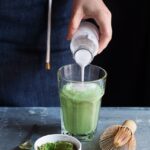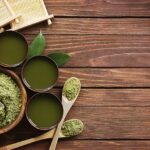The Kratom Conundrum: Unraveling the Leaf versus Powder Debate
In recent years, an enigmatic plant known as kratom has attracted an immense amount of attention worldwide. Hailing from Southeast Asia, this botanical substance has been used for centuries in traditional medicine and cultural practices. However, as public interest grows, so does the ongoing debate surrounding the most effective form of ingestion: leaf or powder. Are the benefits of consuming kratom best derived from its natural state or through the modernized powder form? Join us as we delve into the heart of the Kratom Conundrum and explore the arguments from both sides. Prepare to embark on a journey through its rich history, diverse uses, and the scientific evidence that unravels this perplexing leaf versus powder paradox.
1. Understanding Kratom: A Comprehensive Exploration of its Origins, Uses, and Effects
Native to Southeast Asia, Kratom is a tropical evergreen tree known botanically as Mitragyna speciosa. Its leaves have been traditionally used for centuries by local communities for their medicinal and recreational properties. This comprehensive exploration aims to delve into the intricate world of Kratom, shedding light on its origins, diverse uses, and potential effects.
1. Origins of Kratom:
- Kratom is indigenous to countries such as Thailand, Malaysia, Indonesia, and Papua New Guinea, where it thrives in the lush jungles and rainforests.
- Local populations have utilized various parts of the Kratom tree for religious ceremonies, relaxation, and energy-boosting purposes for generations.
- The cultivation and processing of Kratom leaves involve meticulous methods, including harvesting, drying, and grinding, to ensure the preservation of its potent alkaloids.
2. Uses of Kratom:
- Kratom has a diverse range of applications, including traditional medicine, recreational purposes, and even as a natural stimulant or relaxant.
- In certain cultures, Kratom leaves are commonly chewed or brewed into teas to combat fatigue, relieve pain, manage stress, or aid in opiate withdrawal.
- Furthermore, some individuals consume Kratom to enhance focus, productivity, or simply to experience a mild euphoria.
3. Effects of Kratom:
- The effects of Kratom can vary depending on the consumed strain, dosage, and individual factors such as metabolism and body chemistry.
- Typically, low doses of Kratom induce stimulant-like effects, including increased energy, heightened mood, and enhanced sociability.
- Conversely, higher doses may result in sedative effects, promoting relaxation, pain relief, and potential sedation.
As this exploration unfolds, we aim to provide an in-depth understanding of Kratom, its origins, diverse uses, and potential effects. By delving into its rich history and unraveling the science behind its mechanisms, we hope to shed light on this fascinating botanical and its place in our modern world.

2. Demystifying the Kratom Conundrum: The Dueling Perspectives of Kratom Leaves versus Powders
When it comes to kratom, there are two primary forms in which this versatile plant is typically consumed – as whole kratom leaves or as powdered kratom. Each form has its own unique merits and properties, leading to a longstanding debate among kratom enthusiasts. Let’s delve into the dueling perspectives of kratom leaves versus powders.
Kratom Leaves:
- Whole kratom leaves are known for their potency and purity, as they are minimally processed.
- The leaves are harvested from the kratom tree and can be chewed, brewed into teas, or infused in various culinary recipes.
- Kratom leaves contain the full spectrum of alkaloids naturally present, offering a wide range of benefits.
- Some users argue that consuming kratom leaves promotes a more holistic experience, as it preserves the plant’s natural state.
- However, the taste of kratom leaves can be bitter and unappealing to some individuals.
Kratom Powders:
- Kratom powders are derived from kratom leaves and processed into a fine powder form.
- The powder can be easily mixed into beverages or encapsulated for convenient consumption.
- Some proponents believe that kratom powders offer a more consistent dosage, making it easier to regulate intake.
- Additionally, the powder form allows for greater versatility, as it can be added to smoothies, baked goods, and other creative recipes.
- However, critics argue that the processing involved in creating powdered kratom may result in the loss of certain beneficial compounds.
Ultimately, the choice between kratom leaves and powders boils down to personal preference and desired outcomes. Whether you prefer the pure and natural experience of kratom leaves or the convenience and versatility of powdered kratom, one thing is clear – kratom continues to captivate and confound individuals with its myriad of benefits and forms.

3. The Botanical Battle: Analyzing the Differences Between Kratom Leaves and Powdered Forms
When it comes to kratom, there are two main forms in which it is commonly consumed – leaves and powdered forms. Understanding the differences between these two forms is crucial in determining which one suits your needs and preferences.
One key difference between kratom leaves and powdered forms is their preparation method. Kratom leaves are typically harvested by hand, dried, and then crushed into a fine powder. The powdered form, on the other hand, undergoes a more extensive process that involves grinding and sifting the leaves to create a finer and more concentrated product. This process often yields a more potent and faster-acting form of kratom.
- **Potency**: Powdered kratom is known to be more potent due to its concentrated nature, making it the preferred choice for those seeking stronger effects.
- **Convenience**: While some may argue that leaves offer a more traditional experience, powdered kratom provides added convenience. It can be easily measured and stored, allowing for precise dosage control and long-term storage.
- **Taste and Texture**: Leaves are often described as bitter-tasting and have a rougher texture. Powdered kratom, on the other hand, is generally easier to consume and has a milder taste, making it more palatable for many users.
- **Versatility**: The powdered form of kratom offers greater versatility as it can be easily mixed with other substances, such as water or juice, for consumption. This flexibility allows users to experiment with different methods of ingestion and find what works best for them.
Whether you prefer the traditional experience of chewing kratom leaves or the convenience and potency of powdered forms, understanding the differences between the two can help you make an informed decision. It’s important to consider your personal preferences, desired effects, and convenience when choosing the form of kratom that best suits your needs.

4. Unveiling the Chemistry: How the Extraction Process Alters Kratom’s Potency and Composition
The extraction process plays a critical role in determining the potency and composition of kratom products. By subjecting kratom leaves to various techniques, the alkaloids responsible for its effects can be concentrated, modified, or even removed. Understanding this chemistry sheds light on why different strains of kratom produce varying effects, allowing consumers to make informed decisions based on their desired experience.
1. Concentration of Alkaloids: Through extraction, the alkaloid content in kratom can be intensified, resulting in a more potent product. This process allows manufacturers to adjust the alkaloid profile to achieve specific effects. For instance, the extraction can focus on enhancing mitragynine, the primary alkaloid responsible for kratom’s stimulating properties, or 7-hydroxymitragynine, which contributes to its analgesic and sedating effects.
2. Alkaloid Modification: The extraction process can also modify the alkaloid content to create unique blends. By tweaking variables such as temperature, pressure, and duration, the ratio of different alkaloids can be altered. This results in diverse kratom strains with distinct effects. For example, a higher 7-hydroxymitragynine concentration may lead to a strain renowned for its relaxation properties, while more mitragynine creates a strain favored for its stimulating characteristics.
5. The Leaf Legacy: Ancient Rituals and Cultural Significance of Consuming Whole Kratom Leaves
Kratom, a tropical evergreen tree native to Southeast Asia, has a rich cultural history deeply intertwined with ancient rituals and traditional practices. Throughout the ages, consuming whole kratom leaves has held significant cultural importance, passing down the leaf legacy from one generation to another.
At the heart of these ancient rituals is the recognition of kratom’s powerful effects when consumed in its purest form. The practice involves carefully handpicking mature kratom leaves and preparing them for consumption.
- The leaves are carefully harvested from kratom trees grown in lush forests.
- They are then dried and crushed into a fine powder or brewed into a tea.
- Some cultural practices involve rolling fresh kratom leaves into a quid, which is then chewed.
This preservation of the whole leaf is due to the belief that it encapsulates the spiritual essence and therapeutic properties of kratom. The cultural significance of consuming whole kratom leaves lies in its historical ties to spiritual rituals, communal gatherings, and medicinal practices.
Apart from the spiritual and cultural aspects, the consumption of whole kratom leaves is recognized for its numerous potential benefits. Traditional users believe in its ability to boost energy levels, provide pain relief, enhance mood, and promote relaxation. These effects are attributed to the leaf’s natural alkaloids, such as mitragynine and 7-hydroxymitragynine.
6. Powder Power: Unleashing the Potential Benefits of Processed Kratom for Modern Users
The popularity of kratom has been on the rise in recent years, with more and more people flocking to try this natural supplement. Traditionally used in Southeast Asia, kratom is derived from the leaves of the Mitragyna speciosa tree and has gained a reputation for its potential health benefits. While the plant is primarily consumed as a powder, recent advancements in processing techniques have led to the development of processed kratom, which offers enhanced convenience and potency for modern users.
Here are some potential benefits of processed kratom:
- Increased bioavailability: With processed kratom, the active compounds in the plant are broken down and concentrated, resulting in a higher bioavailability. This means that the body can absorb and utilize the beneficial compounds more efficiently, leading to quicker and more potent effects.
- Variety of consumption methods: Processed kratom is available in various forms such as capsules, extracts, and tinctures, providing users with a wide range of options for consumption. Whether you prefer the convenience of capsules or the versatility of tinctures, there is a processed kratom product to suit your preferences.
- Standardization of dosage: Unlike traditional kratom powder, which can vary in potency depending on factors like growing conditions and harvesting techniques, processed kratom undergoes strict quality control measures. This ensures a standardized dosage, allowing users to accurately measure and regulate their intake for a more consistent experience.
These are just a few examples of the potential benefits that processed kratom can offer modern users. As with any supplement, it is important to exercise caution and consult with a healthcare professional before incorporating it into your routine. With the continued advancements in processing techniques, processed kratom holds promising potential for those seeking an enhanced kratom experience.
7. Seeking the Perfect Match: Choosing Between Kratom Leaves and Powdered Forms for Your Personal Preference and Needs
In the world of kratom, there are two popular forms available: kratom leaves and powdered kratom. Each form has its own unique characteristics that cater to different preferences and needs. If you’re new to kratom or considering switching between the two, it’s essential to understand the key differences and weigh the pros and cons.
1. Kratom Leaves
Kratom leaves are the most traditional and natural form of kratom. They are harvested from the Mitragyna speciosa tree, which grows primarily in Southeast Asia. Here are some aspects to consider:
- Pure and unprocessed: Kratom leaves are harvested and dried without any additional processing, preserving the natural composition of alkaloids present in the leaves.
- Flexibility in consumption: Leaves can be consumed in various forms such as chewing, brewing as tea, or even smoking. The versatility allows users to experiment and discover the method that suits them best.
- Less potency control: The alkaloid content in kratom leaves can vary depending on the region, climate, and soil conditions, making it more challenging to precisely control the potency of each dose.
2. Powdered Kratom
To create powdered kratom, the leaves undergo a specialized grinding process. This transforms the leaves into a fine powder that is more convenient and versatile for usage:
- Easy measurement and dosage: Powdered kratom offers precise dosing control, allowing users to measure and consume their desired amount accurately. This is particularly beneficial for individuals who require consistent dosage for specific needs.
- Faster onset and absorption: The fine texture of the powder facilitates quicker absorption and onset of effects in the body, compared to the leaves, which require more time for digestion and processing.
- Potential compromised quality: Depending on the source and processing techniques, powdered kratom may risk losing some of its natural alkaloid composition, which can in turn affect the overall potency.
FAQ
Q: What is kratom and why is it a topic of debate?
A: Kratom is a tropical evergreen tree native to Southeast Asia, and its leaves contain compounds that have both stimulant and sedative effects. The plant has gained attention in recent years due to its potential health benefits, but also due to concerns about its safety and legality.
Q: What are the main forms in which kratom is consumed?
A: Kratom is commonly consumed in two forms: as crushed leaves or as a fine powder. The crushed leaves can be chewed, brewed into tea, or even smoked. The powder is often mixed with liquids or added to food.
Q: What are the arguments for using kratom in leaf form?
A: Supporters of consuming kratom in leaf form argue that it is more natural and closer to the traditional way it has been used in Southeast Asia for centuries. They believe that chewing the leaves or preparing tea allows for a more balanced and holistic experience, as the natural compounds are preserved.
Q: Why is there a growing preference for using kratom in powdered form?
A: One of the main reasons for the rise in popularity of powdered kratom is convenience. The powder can be easily measured and consumed discreetly, making it more suitable for those who wish to incorporate it into their daily routine. Powdered kratom is also commonly used to create capsules or tablets, ensuring consistent dosages.
Q: How does the potency of kratom differ between leaf and powder?
A: It is generally believed that the powdered form of kratom is more potent compared to the crushed leaves. The drying and grinding process used to make the powder can potentially concentrate the beneficial alkaloids found in kratom, leading to a stronger effect when consumed.
Q: Are there any safety concerns associated with kratom consumption?
A: Yes, there are safety concerns surrounding kratom use. The U.S. Food and Drug Administration (FDA) has raised alarms about potential risks, including addiction, overdose, and even death. There have been reports of kratom being laced with other substances, making it even more dangerous. It is important for consumers to approach kratom with caution and consult with healthcare professionals.
Q: Is the kratom leaf versus powder debate likely to be resolved?
A: It is unlikely that the debate will be resolved anytime soon. Both forms of kratom consumption have their respective supporters, and personal preferences and cultural traditions play a significant role in shaping opinions. More scientific research is needed to fully understand the effects and risks of both methods of consumption.
Q: What can consumers do to ensure a safe kratom experience?
A: Consumers should exercise caution when purchasing kratom and opt for reputable sources that ensure quality and purity. It is crucial to educate oneself about proper dosage, potential side effects, and any potential drug interactions. Additionally, consulting with healthcare professionals, such as doctors or pharmacists, can provide valuable guidance and ensure a safer experience.
Conclusion
In conclusion, the debate between the leaf and powder forms of kratom leaves us grappling with a conundrum. While both options offer unique advantages, the decision ultimately comes down to personal preference and desired effects. Whether you opt for the traditional approach of using raw leaves or go for the convenience of powdered kratom, it is crucial to prioritize safety, quality, and responsible usage.
As we have explored, the leaf form preserves the plant’s natural state, allowing for a more holistic experience. Its slow-release properties provide a gradual onset of effects, making it ideal for those seeking a milder and longer-lasting experience. Moreover, the leaf form allows for versatility in consumption, from chewing directly to brewing as tea.
On the other hand, powdered kratom offers a convenient way to enjoy the herb’s benefits. With its fine texture, it enables easy mixing and absorption, making it suitable for those seeking a more potent and rapid effect. Whether added to beverages or encapsulated for precise dosage, the powder form guarantees a more standardized experience.
Nevertheless, it is essential to remain cautious when navigating the kratom market. Adhering to responsible sourcing practices ensures that you receive a product free from contaminants and of consistent quality. Furthermore, consulting with healthcare professionals and abiding by recommended dosages will contribute to a safe and enjoyable encounter with kratom, regardless of the form chosen.
In this age of modern discovery, the kratom conundrum serves as a testament to the diverse ways in which nature can be harnessed for our well-being. While the leaf versus powder debate will continue to unfold, it is the responsibility of the kratom community to ensure an informed and respectful conversation. By understanding the nuances of each form, we can cultivate a greater appreciation for kratom’s rich history and potential.
So, fellow kratom enthusiasts, as you explore the world of this remarkable plant, may you unravel the conundrum with an open mind. Whether you are captivated by the classic charm of the leaf or enticed by the convenience of the powder, let your decision reflect your desires, preferences, and quest for a well-balanced kratom experience. Embracing the leaf or the powder, remember, it is the essence of kratom that binds us all.






